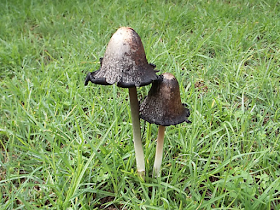🍄 The bliss of gardening on my little piece of African soil. A year-by-year record of the progress in my old garden. My "new" garden of 2000sq.m. started in 2004, and ended when we sold our smallholding in 2017and moved to the Dolphin Coast in KwaZulu Natal. Now "my garden" consists of a postage-stamp-size mostly-indigenous succulent garden and it always amazes me how supposedly drought-resistant plants do so well in this tropical coastal region.
Pages
▼
Sunday, 3 July 2016
Coprinus comatus - Shaggy Mane
Suddenly appearing in people’s lawns (these two in my chicken enclosure) — in troops or lines or rings — this mushroom is well known and relatively easily recognized. Its distinguishing features include its shape and stature and the fact that the gills “deliquesce,” turning themselves into black ink as they mature. The flesh of the mushroom is white and has a mild taste. and this mushroom grows in groups and is sometimes found in unexpected places, like grassy areas in towns. The Shaggy ink-cap occurs widely in grasslands and meadows throughout South Africa.
Luckily, there are only a handful of mushrooms in South Africa that are poisonous. So if you learn these first, the rest are all edible or inedible, but not poisonous. This leaves you open to a world of free food.
Shaggy manes are easy to identify with their conical to bell-shaped white caps (2-5 in / 5-12 cm in height) with big white scales, hence “shaggy mane”. The whole mushroom itself can reach over 12 in (30 cm), but normally grows to 8 in (20 cm). If you plan on frying up this delicious mushroom you must act fast. It is best to collect young specimen as their is no point in collecting mushrooms whose caps are already turning black. Once the mushroom has reached maturity, the cap with its crowded gills blackens quickly — the whole cap turns into a black ink-like liquid, stained by the black spores.
